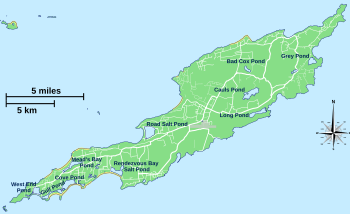Cove Pond: Difference between revisions
Jump to navigation
Jump to search
Created page with "right|thumb|350px|Map of Anguilla's ponds {{territory|British Virgin Islands}} '''Cove Pond''' is a shallow, 709-acre wetland at the south-west..." |
No edit summary |
||
| Line 1: | Line 1: | ||
[[File:Anguilla ponds map.svg|right|thumb|350px|Map of Anguilla's ponds]] | [[File:Anguilla ponds map.svg|right|thumb|350px|Map of Anguilla's ponds]] | ||
{{territory| | {{territory|Anguilla}} | ||
'''Cove Pond''' is a shallow, 709-acre wetland at the south-western end of the main island of [[Anguilla]]. It forms part of a larger coastal lagoon from which it is separated by a causeway constructed for access to the Cap Juluca resort. | '''Cove Pond''' is a shallow, 709-acre wetland at the south-western end of the main island of [[Anguilla]]. It forms part of a larger coastal lagoon from which it is separated by a causeway constructed for access to the Cap Juluca resort. | ||
==Important Bird Area== | ==Important Bird Area== | ||
The wetland has been identified as an Important Bird Area by BirdLife International because it provides nesting, resting, and feeding habitat for over 40 bird species, including a breeding colony of least terns and wintering common terns. Snowy and piping plovers have been recorded, as have the green-throated carib and the Lesser Antillean bullfinch.<ref>{{ | The wetland has been identified as an Important Bird Area by BirdLife International because it provides nesting, resting, and feeding habitat for over 40 bird species, including a breeding colony of least terns and wintering common terns. Snowy and piping plovers have been recorded, as have the green-throated carib and the Lesser Antillean bullfinch.<ref>{{iba}}</ref> | ||
==References== | ==References== | ||
Latest revision as of 17:53, 9 January 2018

Cove Pond is a shallow, 709-acre wetland at the south-western end of the main island of Anguilla. It forms part of a larger coastal lagoon from which it is separated by a causeway constructed for access to the Cap Juluca resort.
Important Bird Area
The wetland has been identified as an Important Bird Area by BirdLife International because it provides nesting, resting, and feeding habitat for over 40 bird species, including a breeding colony of least terns and wintering common terns. Snowy and piping plovers have been recorded, as have the green-throated carib and the Lesser Antillean bullfinch.[1]
References
- ↑ Cove Pond IBA: BirdLife International
- Location map: 18°10’15"N, 63°8’13"W